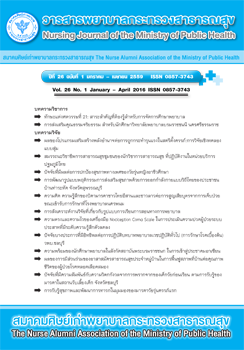ปัจจัยที่มีผลต่อการปกป้องสุขภาพทางเพศของวัยรุ่นหญิงอาชีวศึกษา
Main Article Content
Abstract
บทคัดย่อ
การวิจัยเชิงทำนายนี้มีวัตถุประสงค์เพื่อศึกษาระดับการปกป้องสุขภาพทางเพศ และปัจจัยทำนายการปกป้องสุขภาพทางเพศของวัยรุ่นหญิงอาชีวศึกษา กลุ่มตัวอย่างเป็นนักเรียนหญิงที่ศึกษาระดับประกาศนียบัตรวิชาชีพ ชั้นปีที่ 1 สังกัดกรมอาชีวศึกษา จำนวน 100 คน มีการสุ่มกลุ่มตัวอย่างแบบแบ่งกลุ่ม เครื่องมือที่ใช้ในการเก็บรวบรวมข้อมูลเป็นแบบสอบถามจำนวน 6 ชุด ประกอบด้วย (1) แบบสอบถามข้อมูลทั่วไป (2) แบบสอบถามสัมพันธภาพในครอบครัว (3) แบบสอบถามค่านิยมทางเพศ (4) แบบสอบถามอิทธิพลจากกลุ่มเพื่อน (5) แบบสอบถามการมุ่งอนาคต-ควบคุมตนเอง และ (6) แบบสอบถามการปกป้องสุขภาพทางเพศ เครื่องมือวิจัยทุกชุดได้ผ่านการตรวจสอบความตรงของเนื้อหาโดยผู้ทรงคุณวุฒิ 3 ท่าน และทดสอบความเที่ยงของเครื่องมือได้ค่าสัมประสิทธิ์แอลฟาของครอนบาค ระหว่าง .88-.96 วิเคราะห์ข้อมูลโดยใช้ ความถี่ ร้อยละ ค่าเฉลี่ย ส่วนเบี่ยงเบนมาตรฐาน ความสัมพันธ์แบบเพียรสัน และการวิเคราะห์ถดถอยพหุคูณ
ผลการวิจัยพบว่า การปกป้องสุขภาพทางเพศของวัยรุ่นหญิงอาชีวะโดยรวมอยู่ในระดับสูง (x= 3.14, S.D. = 0.38) เมื่อพิจารณารายด้าน พบว่ามีค่าคะแนนเฉลี่ยในระดับสูง 5 ด้าน คือ การปกป้องเพื่อต่อต้านการมีเพศสัมพันธ์ (x= 3.34, S.D. = 0.49) การรับรู้สิ่งคุกคามที่มาจากโรคเอดส์/โรคติดเชื้อทางเพศสัมพันธ์และการตั้งครรภ์ไม่พึงปรารถนา (x= 3.33, S.D. = 0.56) การตื่นตัวในการค้นหาข้อมูลสุขภาพทางเพศ (x= 3.22, S.D. = 0.60) การสื่อสารกับพ่อแม่และกลุ่มเพื่อนเกี่ยวกับการมีเพศสัมพันธ์ที่ปลอดภัย (x= 3.21, S.D. = 0.54) การแสดงออกอย่างเปิดเผยในการค้นหาข้อมูล (= 3.18, S.D. = 0.68) ส่วนค่าเฉลี่ยการปกป้องสุขภาพทางเพศที่อยู่ในระดับปานกลาง 3 ด้าน ได้แก่ การไม่มีกิจกรรมเกี่ยวกับเรื่องเพศสัมพันธ์ (x= 2.90, S.D. = 0.44) การป้องกันตนเอง (x= 2.75, S.D. = 0.35) และการรับรู้ความอ่อนแอในการปฏิบัติการมีเพศสัมพันธ์ที่ปลอดภัย (x= 2.70, S.D. = 0.70) ปัจจัยที่มีผลต่อการปกป้องสุขภาพทางเพศ มีเพียงปัจจัยเดียว คือ การมุ่งอนาคต–ควบคุมตนเอง สามารถทำนายการปกป้องสุขภาพทางเพศได้ ร้อยละ 45 (R2 = .45, p < .001)
ผลการศึกษานี้แสดงให้เห็นว่า การมุ่งอนาคต–ควบคุมตนเอง มีผลต่อการปกป้องสุขภาพทางเพศของวัยรุ่นหญิงอาชีวศึกษา สามารถนำผลการวิจัยไปเป็นข้อมูลพื้นฐานสำหรับบุคลากรทีมสุขภาพ เพื่อใช้เป็นแนวทางในการส่งเสริม ให้วัยรุ่นหญิงอาชีวศึกษามีการปกป้องสุขภาพทางเพศได้อย่างมีประสิทธิภาพต่อไป
คำสำคัญ : การปกป้องสุขภาพทางเพศ; ปัจจัย; วัยรุ่นหญิงอาชีวศึกษา
* นักศึกษาพยาบาลศาสตรมหาบัญฑิต สาขาการพยาบาลเวชปฏิบัติชุมชน; อีเมล์ติดต่อ: aom_np@hotmail.co.th
** ภาควิชาการพยาบาลสูติ-นรีเวชและผดุงครรภ์ คณะพยาบาลศาสตร์ มหาวิทยาลัยสงขลานครินทร์ สงขลา
Factors Affecting the Sexual Health Protection of
Female Adolescents in Vocational School
Suphannika Lakkla*
Sopen Chunuan**
Sasikarn Kala**
Abstract
The purpose of this study was to investigate the level of sexual health protection and factors affecting the sexual health protection of female adolescents in a vocational school. The sample consisted of 100 first-year female students in a vocational school and was selected using cluster random sampling. The instruments for data collection consisted of 6 questionnaires on (1) Demographic Characteristics (2) Family Relationships, (3) Sexual Values, (4) Future Orientation and Self-Control, (5) Influence of Peers, and a (6) Sexual Health Protection Scale. The content of all questionnaires was validated by three experts and the reliability was tested using Cronbach’s alpha, yielding values ranging between 0.88 and 0.96. Data were analyzed using percentage, mean, standard deviation, Pearson’s product moment correlation and multiple regression.
The results showed that the overall sexual health protection of female adolescents was at a high level (= 3.14, S.D. = 0.38). When considering each dimension, it was found that 5 dimensions of sexual health protection were also at high levels. These dimensions were guarding against having sexual intercourse (x= 3.34, S.D. = 0.49), perceived threats of AIDS, STDS and unwanted pregnancy (x= 3.33, S.D. = 0.56), alertness to search for information on sexual health (x= 3.22, S.D. = 0.60), communication with parents and peers about safe sex (x= 3.21, S.D. = 0.54), and assertiveness in seeking information (x= 3.18, S.D. = 0.68). Mean scores of sexual health protection in other dimensions were at moderate levels: abstinence from sexual activity (x= 2.90, S.D. = 0.44), self-protection (= 2.75, S.D. = 0.35), and perceiving vulnerability of safe sex practices (x=2.70, S.D. = 0.70). Regression modeling showed that future
orientation and self-control could explain 45 percent of the variance in sexual health protection (R2 = .45, p < 0.001)
The results showed that future orientation and self-control were effective in enhancing sexual health protection of female adolescents in vocational schools. These findings can be used as basic information for health care providers in order to establish practice guidelines to promote sexual health protection in this group of adolescents.
Key words : sexual health protection; factor; female adolescents in vocational school
* Master of Nursing Science in Community Nurse Practitioner, Prince of Songkla University; e-mail:aom_np@hotmail.co.th
** Faculty of Nursing, Prince of Songkla University, Songkhla
Article Details
บทความและรายงานวิจัยในวารสารพยาบาลกระทรวงสาธารณสุข เป็นความคิดเห็นของ ผู้เขียน มิใช่ของคณะผู้จัดทำ และมิใช่ความรับผิดชอบของสมาคมศิษย์เก่าพยาบาลกระทรวงสาธารณสุข ซึ่งสามารถนำไปอ้างอิงได้
